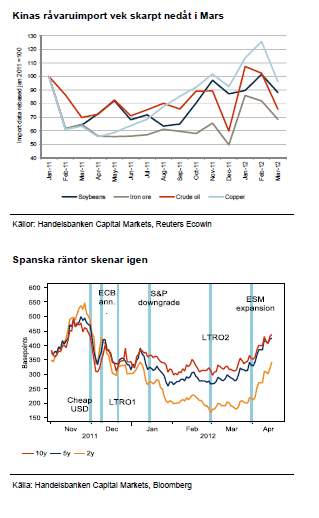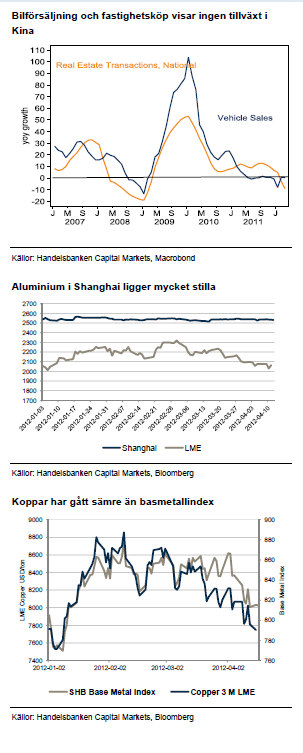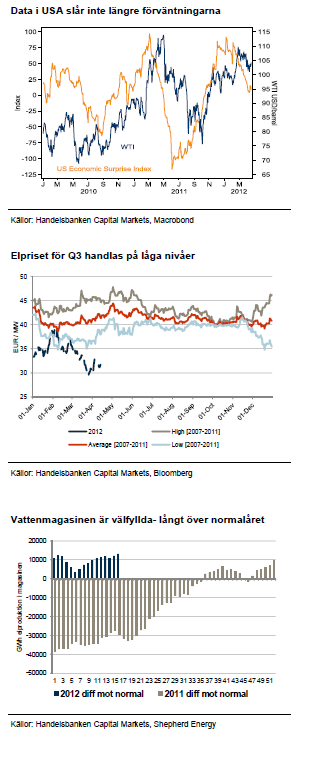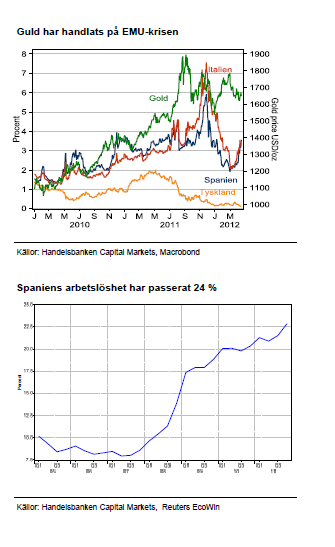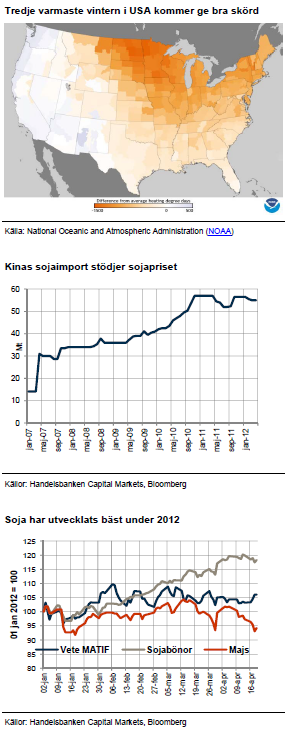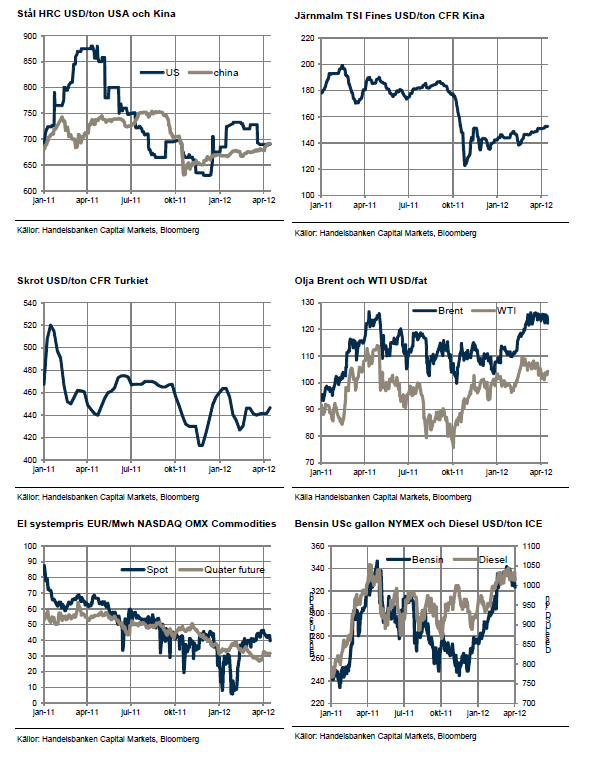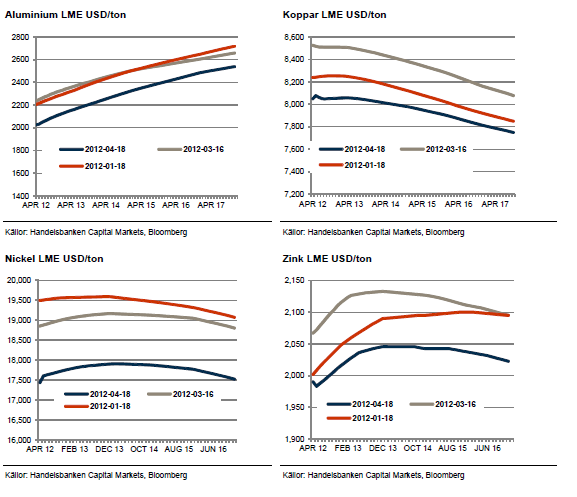Analys
SHB Råvaruplanket 20 april 2012
Kinafrossa och slut på stimulans i väst
 Vi håller basmetallerna lågt
Vi håller basmetallerna lågt
Sedan november har kinafrossan tilltagit på marknaden. Data för första kvartalet och våra intryck från vårt Kinabesök i mars bekräftar nedåtrisker för konjunkturen. Vi ser därför fortsatt press på basmetallerna. Speciellt koppar har fallhöjd och vår riktkurs fram till Q3 är 7200 dollar.
Oljan är svartepetter
Makrodata ger inte längre stöd för ett högre oljepris. Den ständiga strömmen av utbudsstörningar och den pyrande konflikten med Iran i centrum motiverar emellertid fortfarande en viss riskpremie. Vi ser två alternativa scenarier för de kommande två kvartalen. Antingen pyser riskpremien ut och Brentoljan faller ner till omkring 110-115 dollar eller så eskalerar situationen kring Iran och vi får se en ny skarp prisuppgång.
Ädelmetaller vänder upp
Guld och silver handlades under 2011 på eurokrisens uppoch nedgångar. Sedan ECB tog krafttag i slutet på förra året och ökade likviditeten i eurosystemet har de ädla metallerna kommit på fall. Nu klingar effekten från de nytryckta pengarna av och Spanien och Italien ser åter dystert ut. Vi drar upp guld och silver på tron att investerare åter kommer behöva en säker hamn i Europa.
Grödorna kommer upp efter kylan
Efter att livsmedelskorgens lågsäsong ligger bakom oss spirar nu vetet på fälten i USA som haft den tredje varmaste vintern sedan 1893. God övervintring och de största sådda arealerna sedan mätningarna började av vete och majs borgar för god skörd och vi sätter sälj på majs och vete.
Basmetaller
Lägre tillväxtmål var starten
Wen Jiabao sköt av startskottet för oron kring Kina när han sänkte det officiella tillväxtmålet för Kina från 8 till 7,5 % för 2012. Ett litet steg för Kina, men med ett stort symbolvärde för omvärlden. Därefter har Wen också sagt att han vill se lägre fastighetspriser. Sedan har vi inte hört mer utan fått förlita oss till data som kommit från Kina under mars månad. Efter januari och februari som är statistiskt svårtolkade månader på grund av nyårsfirandet har marsdata inte visat på den styrka man hade hoppats på.
Under det första kvartalet har BNP, råvaruimport, fastighetspriser och inköpschefsindex kommit in på svaga nivåer i Kina. Vi tror att priserna på de kinaexponerade basmetallerna kommer att falla ytterligare före Kinas ekonomi börjar respondera på de lättnader som krävs för att hålla tillväxten inom utstakad bana. Kina är på väg mot det sämsta året på tio, undantaget finanskrisen 2008, i termer av BNP tillväxt. Den sämre aktiviteten i byggsektorn och fordonstillverkningen får främst effekter för konsumtionen av stål, koppar, zink och aluminium. Marsinflationen kom in på 3,6 % vilket var högre än förväntat och visar att inflationsspöket hotar även efter att tillväxten kommit ner. Inflationen och regeringens vilja att bromsa fastighetspriserna talar för att den som väntar på stimulans de kommande månaderna kan bli besviken.
Givet att basmetaller förutom koppar har fallit ordentligt redan innan Kina bromsade upp ser vi klart större fallhöjd i koppar än i de övriga basmetallerna fram till Q3. Därefter, när den nuvarande korrigeringen är färdig råder dock det omvända förhållandet. Koppar är något Kina kommer att behöva och när kreditgivningen ökar och lagercykeln ska fyllas på igen kommer koppar att stiga mer än de övriga basmetallerna. Vi förväntar oss alltså en korrigering under de kommande månaderna som sedan omvänds till ett köpläge för koppar.
Energi
Oljan är svartepetter
Uppskattningar av Brentprisets riskpremie kopplad till Iranrelaterad utbudsstörning varierade mellan 5 och 25 USD när priset låg på 125 USD/fat. Vårt antagande är att ungefär 10 dollar kommer från utbudsstörningar (Iran med flera) och 10 dollar kommer från allmänt bättre förväntningar på den globala konjunkturen under 2012.
Med ett USA som tillfälligt toppat och ett Kina som både signalerat och levt upp till lägre tillväxtnivåer har väldens råvaruhandlare blivit mer kallsinniga till den likvida favoriten råolja. Ett sämre sentiment kring olja är en viktig kraft och vi kan se att investerare säljer av oljeinnehav.
Oron kring Iran har inte eskalerat utan snarare minskat i takt med att ”konstruktiva” samtal har förts mellan Iran och de fem permanenta länderna i FN + Tyskland.
Även om inte samtalen löser år av konflikter minskar de spänningarna och risken för en militär konflikt. Samtalen kan också leda till att sanktionerna från USA och EU hävs och det skulle leda till att Iran kan exportera sina stora oljelager som man byggt upp under 2012.
IEA:s senaste rapport visade att trenden under de senaste tio kvartalen med en allt mer ansträngd global balans mellan utbud och efterfrågan bröts under första kvartalet. Huvudsakligen beror det på den imponerande ökningen från OPEC (läs Saudi) som fått lagren att stiga något i OECD och stiga vidare i Saudi och Kina.
Rapporten ger en klarare bild till varför Brent toppade under mars och sedan har fallit tillbaka.
Nedtryckt elpris kan falla mer
Fram till sista juni handlas SHB:s sparprodukter mot Q3:s terminspris på el. Uppsidan i det kontraktet är till stor del begränsad när dagens brytpunkt för elproduktion från koleldade kraftverk (kolkondens) ligger omkring EUR 40 och dit är det långt från dagens EUR 32. Vad som kan vara intressant att spela är däremot ett fortsatt fallande pris. Vårfloden lär inte bli så spektakulär i år då vi saknar snö i lägre liggande terräng men vi har redan ett stort energiöverskott i vattenmagasinen och fram emot sommaren när efterfrågan på el minskar ytterligare kan vattnet rinna över breddarna i magasinen. Då kan vi se priser för veckosnittet ner mot EUR 10-15 och det skulle få ner Q3 priset till omkring EUR 25.
Ädelmetaller
Ny våg av EMU-Krisen
Spanien är nu i fokus, snarare än Italien och det med rätta. Den stora Spanienbubblan fortsätter att pysa ut med högre arbetslöshet och påverkan på landets banker och statens finanser. Den nya regeringen håller skenet uppe men har stora problem framför sig. De åtstramningar som har lanserats kommer inte att räcka för att få ner underskottet till under 3 % av BNP under 2013. Arbetslösheten är 24 % och närmar sig 30 % nästa år, vilket talar för att folket kommer vara mycket negativa till ytterligare nedskärningar i statens finanser för att klara budgetmål.
När bankproblemen eskalerar kommer trycket öka på ECB att göra mer för att stödja eurozonen. Räntesänkning och LTRO3 är under uppsegling till hösten. ECB kan hjälpa till att lösa likviditetsbrist men Spaniens brist på soliditet kommer att bli akut och nyemissioner i banker kommer att behövas. Det börjar redan diskonteras i bankernas aktiekurser.
Längre fram hägrar hela tiden risken för en uppbrytning av EMU-samarbetet. Grekland är i så fall troligt att lämna först, följt av Portugal och Spanien. Detta kan inte ske under ordnade former under 2012 och kommer säkerligen heller inte att ske under året men redan diskussionen om att det kan komma att ske kommer vara en stressfaktor på de finansiella marknaderna.
Guld och Silver är rätt kort
I en miljö med ökad finansiell stress och ny svårgreppbar oro för EMU-samarbetet är guld och silver de tillgångar som kommer att gynnas av investerares flykt till säkra tillgångar. Guld och silver brukar stiga i tider av oro. Vi tror inte att Spanienoron kommer att vara speciellt konjunkturpåverkande på global nivå men den kommer skapa tillräckligt stora rubriker för att väcka investerares intresse för de ädla metallerna.
Livsmedel
Vintern är över
Vintern är över och tidigare oro över eventuella vinterskador på norra halvklotets grödor har nu mer eller mindre försvunnit. Fokus ligger nu istället på kommande väder och hur det kommer påverka höstgrödorna samt sådden och uppkomsten av vårgrödorna.
I USA ser utsikterna goda ut för vetet, det amerikanska jordbruksdepartementet, USDA, uppger att skicket på höstvetet är klart bättre än förra året och även bättre än genomsnittet för de senaste fem åren. Samtidigt fortgår sådden av vårvete i rasande takt, omkring hälften av grödan är sådd mot normalt nio procent vid denna tidpunkt på året. Detta skapar goda förutsättningar för en hög avkastning. Europa har tidigare haft problem med torrt väder i delar av exempelvis Frankrike, Storbritannien och östra Polen. Varmare väder önskas och utlovas också. Problem med torka kvarstår dock i delar av Spanien och även i södra Ukraina. I Ryssland uppges allt vara ok, vilket är viktigt givet landets storlek på exportmarknaden.
Rekordsnabb majssådd
Även sådden av majs i USA fortgår i rask takt. Rekordhöga 25 procent av sådden uppges vara avklarad mot normalt 13 procent vid denna tid. Det i kombination med goda väderutsikter borgar precis som för vetet för en kommande hög produktion. Majspriset hålls idag uppe delvis som följd av hård konkurrens med sojabönorna om areal. När den kampen är klar bör majspriserna kunna backa tillbaka något ytterligare, förutsatt att de goda väderutsikterna håller. Stram marknadsbalans och starkt köpintresse från Kina, förmodligen ökande, bör dock begränsa nedgången. Majs och vete är i hög grad substitut till djurfoder och lägre priser på majs leder oftast till lägre priser på vete – som i sig själv har svårt att finna egen styrka till uppgång i dagsläget.
Sojan fortsatt stark
Sedan en tid tillbaka har sojabönorna utvecklats klart bäst prismässigt av de tre stora grödorna och det finns i dagsläget inga direkta skäl till en nedgång. Potential för ytterligare nedjusteringar av den pågående sydamerikanska skörden samt fortsatt väldigt stark efterfrågan från främst Kina kan driva priserna ytterligare något högre. Kinas import under april månad beräknas bli rekordhög. En eventuell uppgång kan dock begränsas när kampen om arealen i USA är klar och sådden avklarad.
Data
[box]SHB Råvaruplanket är producerat av Handelsbanken och publiceras i samarbete och med tillstånd på Råvarumarknaden.se[/box]
Ansvarsbegränsning
Detta material är producerat av Svenska Handelsbanken AB (publ) i fortsättningen kallad Handelsbanken. De som arbetar med innehållet är inte analytiker och materialet är inte oberoende investeringsanalys. Innehållet är uteslutande avsett för kunder i Sverige. Syftet är att ge en allmän information till Handelsbankens kunder och utgör inte ett personligt investeringsråd eller en personlig rekommendation. Informationen ska inte ensamt utgöra underlag för investeringsbeslut. Kunder bör inhämta råd från sina rådgivare och basera sina investeringsbeslut utifrån egen erfarenhet.
Informationen i materialet kan ändras och också avvika från de åsikter som uttrycks i oberoende investeringsanalyser från Handelsbanken. Informationen grundar sig på allmänt tillgänglig information och är hämtad från källor som bedöms som tillförlitliga, men riktigheten kan inte garanteras och informationen kan vara ofullständig eller nedkortad. Ingen del av förslaget får reproduceras eller distribueras till någon annan person utan att Handelsbanken dessförinnan lämnat sitt skriftliga medgivande. Handelsbanken ansvarar inte för att materialet används på ett sätt som strider mot förbudet mot vidarebefordran eller offentliggörs i strid med bankens regler.
Analys
Tightening fundamentals – bullish inventories from DOE

The latest weekly report from the US DOE showed a substantial drawdown across key petroleum categories, adding more upside potential to the fundamental picture.

Commercial crude inventories (excl. SPR) fell by 5.8 million barrels, bringing total inventories down to 415.1 million barrels. Now sitting 11% below the five-year seasonal norm and placed in the lowest 2015-2022 range (see picture below).
Product inventories also tightened further last week. Gasoline inventories declined by 2.1 million barrels, with reductions seen in both finished gasoline and blending components. Current gasoline levels are about 3% below the five-year average for this time of year.
Among products, the most notable move came in diesel, where inventories dropped by almost 4.1 million barrels, deepening the deficit to around 20% below seasonal norms – continuing to underscore the persistent supply tightness in diesel markets.
The only area of inventory growth was in propane/propylene, which posted a significant 5.1-million-barrel build and now stands 9% above the five-year average.
Total commercial petroleum inventories (crude plus refined products) declined by 4.2 million barrels on the week, reinforcing the overall tightening of US crude and products.


Analys
Bombs to ”ceasefire” in hours – Brent below $70

A classic case of “buy the rumor, sell the news” played out in oil markets, as Brent crude has dropped sharply – down nearly USD 10 per barrel since yesterday evening – following Iran’s retaliatory strike on a U.S. air base in Qatar. The immediate reaction was: “That was it?” The strike followed a carefully calibrated, non-escalatory playbook, avoiding direct threats to energy infrastructure or disruption of shipping through the Strait of Hormuz – thus calming worst-case fears.

After Monday morning’s sharp spike to USD 81.4 per barrel, triggered by the U.S. bombing of Iranian nuclear facilities, oil prices drifted sideways in anticipation of a potential Iranian response. That response came with advance warning and caused limited physical damage. Early this morning, both the U.S. President and Iranian state media announced a ceasefire, effectively placing a lid on the immediate conflict risk – at least for now.
As a result, Brent crude has now fallen by a total of USD 12 from Monday’s peak, currently trading around USD 69 per barrel.
Looking beyond geopolitics, the market will now shift its focus to the upcoming OPEC+ meeting in early July. Saudi Arabia’s decision to increase output earlier this year – despite falling prices – has drawn renewed attention considering recent developments. Some suggest this was a response to U.S. pressure to offset potential Iranian supply losses.
However, consensus is that the move was driven more by internal OPEC+ dynamics. After years of curbing production to support prices, Riyadh had grown frustrated with quota-busting by several members (notably Kazakhstan). With Saudi Arabia cutting up to 2 million barrels per day – roughly 2% of global supply – returns were diminishing, and the risk of losing market share was rising. The production increase is widely seen as an effort to reassert leadership and restore discipline within the group.
That said, the FT recently stated that, the Saudis remain wary of past missteps. In 2018, Riyadh ramped up output at Trump’s request ahead of Iran sanctions, only to see prices collapse when the U.S. granted broad waivers – triggering oversupply. Officials have reportedly made it clear they don’t intend to repeat that mistake.
The recent visit by President Trump to Saudi Arabia, which included agreements on AI, defense, and nuclear cooperation, suggests a broader strategic alignment. This has fueled speculation about a quiet “pump-for-politics” deal behind recent production moves.
Looking ahead, oil prices have now retraced the entire rally sparked by the June 13 Israel–Iran escalation. This retreat provides more political and policy space for both the U.S. and Saudi Arabia. Specifically, it makes it easier for Riyadh to scale back its three recent production hikes of 411,000 barrels each, potentially returning to more moderate increases of 137,000 barrels for August and September.
In short: with no major loss of Iranian supply to the market, OPEC+ – led by Saudi Arabia – no longer needs to compensate for a disruption that hasn’t materialized, especially not to please the U.S. at the cost of its own market strategy. As the Saudis themselves have signaled, they are unlikely to repeat previous mistakes.
Conclusion: With Brent now in the high USD 60s, buying oil looks fundamentally justified. The geopolitical premium has deflated, but tensions between Israel and Iran remain unresolved – and the risk of missteps and renewed escalation still lingers. In fact, even this morning, reports have emerged of renewed missile fire despite the declared “truce.” The path forward may be calmer – but it is far from stable.
Analys
A muted price reaction. Market looks relaxed, but it is still on edge waiting for what Iran will do

Brent crossed the 80-line this morning but quickly fell back assigning limited probability for Iran choosing to close the Strait of Hormuz. Brent traded in a range of USD 70.56 – 79.04/b last week as the market fluctuated between ”Iran wants a deal” and ”US is about to attack Iran”. At the end of the week though, Donald Trump managed to convince markets (and probably also Iran) that he would make a decision within two weeks. I.e. no imminent attack. Previously when when he has talked about ”making a decision within two weeks” he has often ended up doing nothing in the end. The oil market relaxed as a result and the week ended at USD 77.01/b which is just USD 6/b above the year to date average of USD 71/b.

Brent jumped to USD 81.4/b this morning, the highest since mid-January, but then quickly fell back to a current price of USD 78.2/b which is only up 1.5% versus the close on Friday. As such the market is pricing a fairly low probability that Iran will actually close the Strait of Hormuz. Probably because it will hurt Iranian oil exports as well as the global oil market.
It was however all smoke and mirrors. Deception. The US attacked Iran on Saturday. The attack involved 125 warplanes, submarines and surface warships and 14 bunker buster bombs were dropped on Iranian nuclear sites including Fordow, Natanz and Isfahan. In response the Iranian Parliament voted in support of closing the Strait of Hormuz where some 17 mb of crude and products is transported to the global market every day plus significant volumes of LNG. This is however merely an advise to the Supreme leader Ayatollah Ali Khamenei and the Supreme National Security Council which sits with the final and actual decision.
No supply of oil is lost yet. It is about the risk of Iran closing the Strait of Hormuz or not. So far not a single drop of oil supply has been lost to the global market. The price at the moment is all about the assessed risk of loss of supply. Will Iran choose to choke of the Strait of Hormuz or not? That is the big question. It would be painful for US consumers, for Donald Trump’s voter base, for the global economy but also for Iran and its population which relies on oil exports and income from selling oil out of that Strait as well. As such it is not a no-brainer choice for Iran to close the Strait for oil exports. And looking at the il price this morning it is clear that the oil market doesn’t assign a very high probability of it happening. It is however probably well within the capability of Iran to close the Strait off with rockets, mines, air-drones and possibly sea-drones. Just look at how Ukraine has been able to control and damage the Russian Black Sea fleet.
What to do about the highly enriched uranium which has gone missing? While the US and Israel can celebrate their destruction of Iranian nuclear facilities they are also scratching their heads over what to do with the lost Iranian nuclear material. Iran had 408 kg of highly enriched uranium (IAEA). Almost weapons grade. Enough for some 10 nuclear warheads. It seems to have been transported out of Fordow before the attack this weekend.
The market is still on edge. USD 80-something/b seems sensible while we wait. The oil market reaction to this weekend’s events is very muted so far. The market is still on edge awaiting what Iran will do. Because Iran will do something. But what and when? An oil price of 80-something seems like a sensible level until something do happen.
-

 Nyheter3 veckor sedan
Nyheter3 veckor sedanMahvie Minerals växlar spår – satsar fullt ut på guld
-

 Nyheter4 veckor sedan
Nyheter4 veckor sedanUppgången i oljepriset planade ut under helgen
-

 Nyheter4 veckor sedan
Nyheter4 veckor sedanLåga elpriser i sommar – men mellersta Sverige får en ökning
-

 Analys3 veckor sedan
Analys3 veckor sedanA muted price reaction. Market looks relaxed, but it is still on edge waiting for what Iran will do
-

 Nyheter3 veckor sedan
Nyheter3 veckor sedanJonas Lindvall är tillbaka med ett nytt oljebolag, Perthro, som ska börsnoteras
-

 Nyheter3 veckor sedan
Nyheter3 veckor sedanOljan, guldet och marknadens oroande tystnad
-

 Analys4 veckor sedan
Analys4 veckor sedanVery relaxed at USD 75/b. Risk barometer will likely fluctuate to higher levels with Brent into the 80ies or higher coming 2-3 weeks
-

 Nyheter3 veckor sedan
Nyheter3 veckor sedanDomstolen ger klartecken till Lappland Guldprospektering


